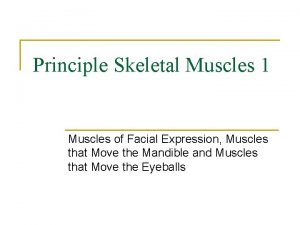Morphometrics Research on Megalonyx Scapulae from the Tarkio

- Slides: 1

Morphometrics Research on Megalonyx Scapulae from the Tarkio Valley Ground Sloth Project Justine Hart University of Iowa, Department of Geoscience ICRU Grant Project The Tarkio Valley Ground Sloth Project Introduction The adult sloth is the second most complete specimen of Megalonyx ever recorded (104 elements). The larger juvenile is also one of the most complete sloths of its size on record (40 elements). The smaller juvenile is represented by only one scapula. However, since the other two specimens also have complete scapulae, this find has turned out to be a very good opportunity to analyze ground sloth ontogeny, as well as investigate questions about juvenile versus adult locomotion, body mass and muscle size. The University of Iowa Geoscience Department and Museum of Natural History are involved in a project recovering the remains of three 12, 000 year-old giant ground sloths (Megalonyx jeffersonii) from Tarkio Valley in southwest Iowa. This is the first time that adult and juvenile sloths have ever been found in association with one another. We have one adult and two juveniles of different sizes to study. As a whole, this project has led to a better understanding of the Pleistocene extinction event, in which 40 large mammal species became extinct simultaneously, and of how ground sloths lived and interacted with one another. Recently, a bone from a fourth sloth of a different species - Paramylodon harlani - was found. It is the first record of Paramylodon in Iowa. The Tarkio Valley project has opened the door to many new research opportunities at the University of Iowa. Morphometrics Two age-relevant people holding the corresponding sloth’s scapula. Morphometrics is the study of growth and development in organisms and is often used as a way to quantify the changes occurring through the lifetime of a species. We will be using a 3 D Microscribe G 2 system (accuracy=0. 38 mm, working sphere= 50”) to digitize data collected from similar landmarks on all three scapulae. This instrument takes measurements from the scapulae themselves to create a digital version with 3 D coordinates. Once the landmarks are recorded, we will be able to study the data and determine information about the life of Megalonyx. The adult scapula, left, and the larger juvenile’s scapula, right, with ruler in inches. 3 D Microscribe G 2 system and a modern sloth scapula. Future Plans This semester, in addition to the three Megalonyx scapulae that we have, we are acquiring additional scapulae specimens from museums around North America, as well as modern sloth scapulae from our Paleontology Repository. We will take the measurements and analyze our data, comparing Megalonyx ontogeny to that of modern ground sloth species. References The baby’s scapula. This bone was found in pieces, so a 3 -D rapid prototype reconstruction was made without removing the bone from the plaster field jacket. The mold will be used for this project. Above: Two pictures of Megalonyx jeffersonii from the excavation site. www. slothcentral. com – Information about the Tarkio Valley Sloth Project http: //www. uiowa. edu/~nathist/ - University of Iowa Museum of Natural History Acknowledgements This project is funded by a UI ICRU Award. Drs Holmes Semken, Ann Budd (UI) and Greg Macdonald (NPS) , and Andy Grass and Tiffany Adrain (UI) and David Brenzel are providing assistance.

